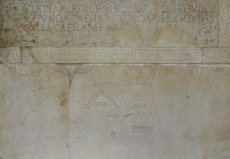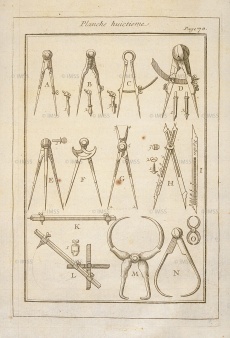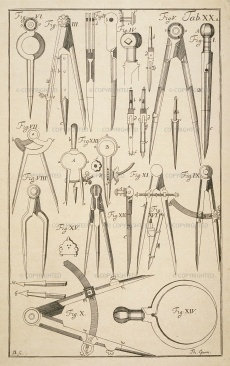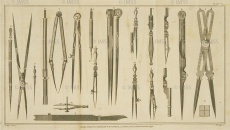Compasses
From Inventions
| (5 intermediate revisions not shown) | |||
| Line 2: | Line 2: | ||
|nome= | |nome= | ||
| - | Since Renaissance times synonymous of seste (compasses), the name derives from the Latin "cum" and "passus", literally "with step", that is, at a measured or constant rhythm. | + | Since Renaissance times synonymous of ''seste'' (compasses), the name derives from the Latin "cum" and "passus", literally "with step", that is, at a measured or constant rhythm. |
|inventore= | |inventore= | ||
| Line 9: | Line 9: | ||
|descrizione= | |descrizione= | ||
| - | Instrument for drawing circles, ellipses and other curved lines. Also instrument of measurement and for transferring measurements. The term "compass" or "compasses" denotes a wide range of instruments for drawing, measurement, and proportional calculation. Besides the more common compasses for drawing circumferences, widespread since antiquity, the Renaissance has left us a great number of special compasses, whose names reflect their specific functions: oval compasses to draw ellipses, hyperbolas and parabolas; two-point | + | Instrument for drawing circles, ellipses and other curved lines. Also instrument of measurement and for transferring measurements. The term "compass" or "compasses" denotes a wide range of instruments for drawing, measurement, and proportional calculation. Besides the more common compasses for drawing circumferences, widespread since antiquity, the Renaissance has left us a great number of special compasses, whose names reflect their specific functions: oval compasses to draw ellipses, hyperbolas and parabolas; two-point compasses — also called [[dividers]] — to divide lines and transfer measurements; [[Single-Handed Dividers | single-handed dividers]], to track routes on sea-charts; compasses with curved points, called [[Caliper Compasses | caliper compasses]], to measure mouths of cannons, cannon balls, and columns; [[Three-Point Compasses | three-point compasses]] to reproduce maps; [[Four-Point Compasses | four-point compasses]], or reduction compasses, to enlarge or reduce drawings, divide lines and circumferences proportionally, and draw polygons; [[Eight-Point Compasses | eight-point compasses]] to measure fractions of degrees and carry out proportional calculations; [[Proportional Compasses | proportional compasses]] to perform arithmetic, geometric, and trigonometric calculations and to measure weights, gradients, and distances for military use; and sophisticated [[Surveying Compasses | surveying compasses]] that combined a magnetic compass, a windrose, and optical sights for surveying and for drawing topographic maps. |
|componenti= | |componenti= | ||
| Line 17: | Line 17: | ||
|strumentiesistenti= | |strumentiesistenti= | ||
| + | - Musée des arts et métiers, Paris<br> | ||
| + | [http://cugnot.cnam.fr:8000/SEARCH/BASIS/collec/internet/objet/DDW?W%3DDESIG+PH+WORDS+%27compas%27+ORDER+BY+DESIG/Ascend%26M%3D12%26K%3D19239%26R%3DY%26U%3D1 Paris, Musée des arts et metiers, inv. 35694-0005-] <br /> | ||
| + | [http://cugnot.cnam.fr:8000/SEARCH/BASIS/collec/internet/objet/DDW?W%3DDESIG+PH+WORDS+%27compas%27+ORDER+BY+DESIG/Ascend%26M%3D13%26K%3D21076%26R%3DY%26U%3D1 Paris, Musée des arts et metiers, inv. 35745-0000-] <br /> | ||
| + | [http://cugnot.cnam.fr:8000/SEARCH/BASIS/collec/internet/objet/DDW?W%3DDESIG+PH+WORDS+%27compas%27+ORDER+BY+DESIG/Ascend%26M%3D14%26K%3D31117%26R%3DY%26U%3D1 Paris, Musée des arts et metiers, inv. 36097-0000-] <br /> | ||
| + | [http://cugnot.cnam.fr:8000/SEARCH/BASIS/collec/internet/objet/DDW?W%3DDESIG+PH+WORDS+%27compas%27+ORDER+BY+DESIG/Ascend%26M%3D17%26K%3D33964%26R%3DY%26U%3D1 Paris, Musée des arts et metiers, inv. 11753-0004-] <br /> | ||
| + | [http://cugnot.cnam.fr:8000/SEARCH/BASIS/collec/internet/objet/DDW?W%3DDESIG+PH+WORDS+%27compas%27+ORDER+BY+DESIG/Ascend%26M%3D16%26K%3D33963%26R%3DY%26U%3D1 Paris, Musée des arts et metiers, inv. 11753-0003-] <br /> | ||
| + | |||
| + | |||
| + | - The Science Museum, London<br> | ||
| + | [http://www.ingenious.org.uk/See/?target=SeeMedium&ObjectID={1ADE8ADC-A4C2-75EA-13FF-943CB677FDDF}&s=S1&SearchString=Compasses&source=Search&viewby=images&cntRead=0&cntDebate=0&cntDCBooks=3&cntDCImages=132& The Science museum, "Compass, probably Flemish, 18th century"]<br> | ||
| + | [http://www.ingenious.org.uk/See/?s=S1&ObjectID={7CDF935A-F7FE-BB0F-A161-812F168A31C3}&source=Search&target=SeeMedium The Science museum, inv. 1918-13]<br> | ||
| + | |||
| + | |||
| + | - Museum of the History of Science, Oxford <br> | ||
| + | [http://emu.mhs.ox.ac.uk/Display.php?irn=9592&QueryPage=%2FAdvQuery.php Museum of the History of Science, Oxford, inv. 52200]<br> | ||
| + | [http://emu.mhs.ox.ac.uk/Display.php?irn=2767&QueryPage=%2FAdvQuery.php Museum of the History of Science, Oxford, inv. 36183]<br> | ||
| + | [http://emu.mhs.ox.ac.uk/Display.php?irn=9603&QueryPage=%2FAdvQuery.php Museum of the History of Science, Oxford, inv. 28777]<br> | ||
| + | [http://emu.mhs.ox.ac.uk/Display.php?irn=10387&QueryPage=%2FAdvQuery.php Museum of the History of Science, Oxford, inv. 55813]<br> | ||
| + | [http://emu.mhs.ox.ac.uk/Display.php?irn=10386&QueryPage=%2FAdvQuery.php Museum of the History of Science, Oxford, inv. 76418]<br> | ||
| + | [http://emu.mhs.ox.ac.uk/Display.php?irn=1938&QueryPage=%2FAdvQuery.php Museum of the History of Science, Oxford, inv. 38132]<br> | ||
| + | [http://emu.mhs.ox.ac.uk/Display.php?irn=9594&QueryPage=%2FAdvQuery.php Museum of the History of Science, Oxford, inv. 45655]<br> | ||
| + | [http://emu.mhs.ox.ac.uk/Display.php?irn=2768&QueryPage=%2FAdvQuery.php Museum of the History of Science, Oxford, inv. 35868]<br> | ||
| + | [http://emu.mhs.ox.ac.uk/Display.php?irn=1226&QueryPage=%2FAdvQuery.php Museum of the History of Science, Oxford, inv. 54823]<br> | ||
| + | |||
|link= | |link= | ||
| Line 22: | Line 46: | ||
|immagini= <gallery widths=230 heights=368 perrow=3> | |immagini= <gallery widths=230 heights=368 perrow=3> | ||
| - | Image: 8528_3202_1692-012.jpg | | + | Image: 8528_3202_1692-012.jpg | Funerary monument of Lucius Alfius Statius (detail), on which are carved a Roman two-foot rule, an ''archipenzolo'' (plumb level), a compasses, a square and a hammer. Aquileia, Museo Archeologico Nazionale.<br /> |
Image: 8528_3202_1659-024.jpg | Nicolas Bion. ''Traité de la construction et des principaux usages des instruments de mathematique : avec les figures necessaires pour l'intelligence de ce Traité'', Paris, 1725, tav. VIII p.70<br /> | Image: 8528_3202_1659-024.jpg | Nicolas Bion. ''Traité de la construction et des principaux usages des instruments de mathematique : avec les figures necessaires pour l'intelligence de ce Traité'', Paris, 1725, tav. VIII p.70<br /> | ||
| Line 35: | Line 59: | ||
|categoria_1= Measuring instruments | |categoria_1= Measuring instruments | ||
| - | |categoria_2= | + | |categoria_2= Drawing instruments |
|categoria_3= | |categoria_3= | ||
|categoria_4= | |categoria_4= | ||
Current revision as of 13:41, 7 September 2010
Since Renaissance times synonymous of seste (compasses), the name derives from the Latin "cum" and "passus", literally "with step", that is, at a measured or constant rhythm.
Contents |
Description
Instrument for drawing circles, ellipses and other curved lines. Also instrument of measurement and for transferring measurements. The term "compass" or "compasses" denotes a wide range of instruments for drawing, measurement, and proportional calculation. Besides the more common compasses for drawing circumferences, widespread since antiquity, the Renaissance has left us a great number of special compasses, whose names reflect their specific functions: oval compasses to draw ellipses, hyperbolas and parabolas; two-point compasses — also called dividers — to divide lines and transfer measurements; single-handed dividers, to track routes on sea-charts; compasses with curved points, called caliper compasses, to measure mouths of cannons, cannon balls, and columns; three-point compasses to reproduce maps; four-point compasses, or reduction compasses, to enlarge or reduce drawings, divide lines and circumferences proportionally, and draw polygons; eight-point compasses to measure fractions of degrees and carry out proportional calculations; proportional compasses to perform arithmetic, geometric, and trigonometric calculations and to measure weights, gradients, and distances for military use; and sophisticated surveying compasses that combined a magnetic compass, a windrose, and optical sights for surveying and for drawing topographic maps.
Bibliographical Resources
Scamozzi, Vincenzo. L’idea della architettura universale, Venezia 1615, Parte I, Lib. I, Cap. XV, p. 49: "…I compassi siano piuttosto d’ottone, che d’altra materia che s’irrugginisca; ben leggieri e sottili di gambe, purchè non tremino, all’uso di Francia…".
Existing Instruments
- Musée des arts et métiers, Paris
Paris, Musée des arts et metiers, inv. 35694-0005-
Paris, Musée des arts et metiers, inv. 35745-0000-
Paris, Musée des arts et metiers, inv. 36097-0000-
Paris, Musée des arts et metiers, inv. 11753-0004-
Paris, Musée des arts et metiers, inv. 11753-0003-
- The Science Museum, London
The Science museum, "Compass, probably Flemish, 18th century"
The Science museum, inv. 1918-13
- Museum of the History of Science, Oxford
Museum of the History of Science, Oxford, inv. 52200
Museum of the History of Science, Oxford, inv. 36183
Museum of the History of Science, Oxford, inv. 28777
Museum of the History of Science, Oxford, inv. 55813
Museum of the History of Science, Oxford, inv. 76418
Museum of the History of Science, Oxford, inv. 38132
Museum of the History of Science, Oxford, inv. 45655
Museum of the History of Science, Oxford, inv. 35868
Museum of the History of Science, Oxford, inv. 54823
Images
Author of the entry: Filippo Camerota




